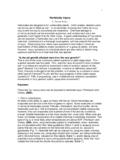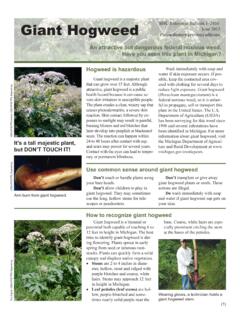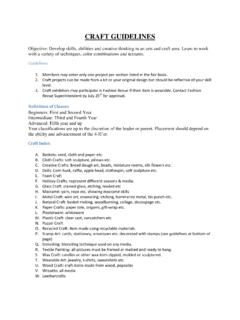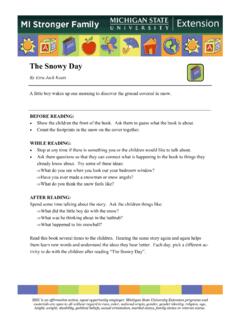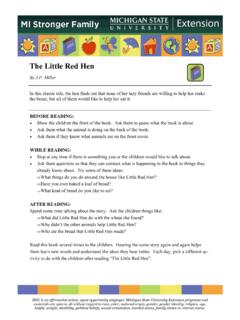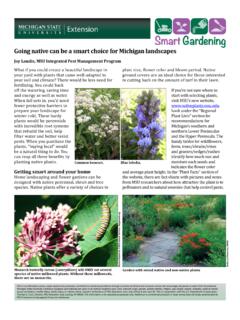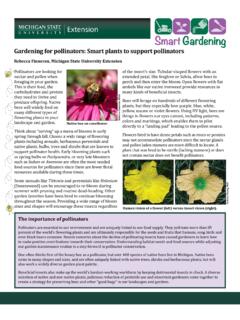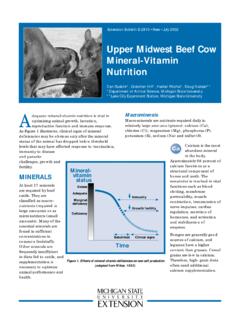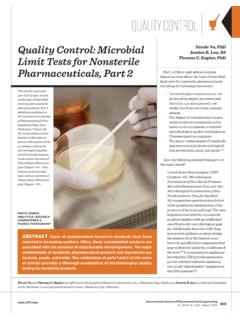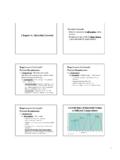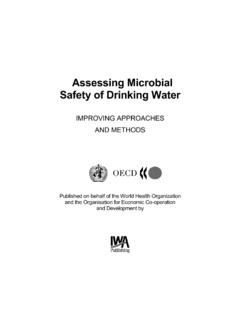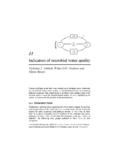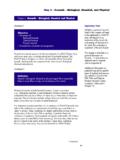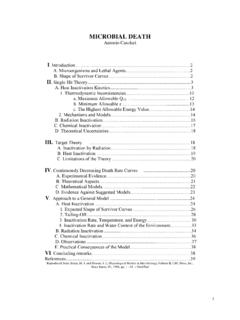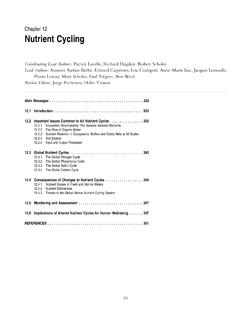Transcription of Chapter 3. Factors that Influence Microbial Growth
1 Chapter 3. Factors that Influence Microbial Growth December 31, 2001. Evaluation and Definition of Potentially Hazardous Foods 1. Introduction The Factors discussed in this section constitute an inclusive, rather than exclusive, list of intrinsic, extrinsic, and other Factors that may be considered when determining whether a food or category of foods requires time/temperature control during storage, distribution, sale and handling at retail and in food service to assure consumer protection. Many Factors must be evaluated for each specific food when making decisions on whether it needs time/temperature control for safety.
2 These can be divided into intrinsic and extrinsic Factors . Intrinsic Factors are those that are characteristic of the food itself; extrinsic Factors are those that refer to the environment surrounding the food. The need for time/temperature control is primarily determined by 1) the potential for contamination with pathogenic microorganisms of concern (including processing influences), and 2) the potential for subsequent Growth and/or toxin production. Most authorities are likely to divide foods among three categories based on an evaluation of the Factors described below: those that do not need time/temperature control for protection of consumer safety; those that need time/temperature control; and those where the exact status is questionable.
3 In the case of questionable products, further scientific evidence--such as modeling of Microbial Growth or death, or actual microbiological challenge studies--may help to inform the decision. 2. Intrinsic Factors Moisture content Microorganisms need water in an available form to grow in food products. The control of the moisture content in foods is one of the oldest exploited preservation strategies. Food microbiologists generally describe the water requirements of microorganisms in terms of the water activity (aw) of the food or environment.
4 Water activity is defined as the ratio of water vapor pressure of the food substrate to the vapor pressure of pure water at the same temperature (Jay 2000b, p 41): aw = p/po, where p = vapor pressure of the solution and po = vapor pressure of the solvent (usually water). The aw of pure water is and the aw of a completely dehydrated food is The aw of a food on this scale from - is related to the equilibrium relative humidity above the food on a scale of 0 - 100%. Thus, % Equilibrium Relative Humidity (ERH) = aw x 100.
5 The aw of a food describes the degree to which water is "bound" in the food, its availability to participate in chemical/biochemical reactions, and its availability to facilitate Growth of microorganisms. Most fresh foods, such as fresh meat, vegetables, and fruits, have awvalues that are close to the optimum Growth level of most microorganisms ( - ). Table 3-1 shows the approximate awlevels of some common food categories. The aw can be manipulated in foods by a number of means, including addition of solutes such as salt or sugar, physical removal of water through drying or baking, or binding of water to various macromolecular components in the food.
6 Weight for weight, these food components will decrease aw in the following order: ionic compounds >. sugars, polyhydric alcohols, amino acids and other low-molecular-weight compounds > high- molecular-weight compounds such as cellulose, protein or starch (Mossel and others 1995, p 63- 109). Microorganisms respond differently to aw depending on a number of Factors . Microbial Growth , and, in some cases, the production of Microbial metabolites, may be particularly sensitive to alterations in aw. Microorganisms generally have optimum and minimum levels of aw for Growth depending on other Growth Factors in their environments.
7 One indicator of Microbial response is their taxonomic classification. For example, Gram (-) bacteria are generally more sensitive to low aw than Gram (+) bacteria. Table 3-2 lists the approximate minimum aw values for the Growth of selected microorganisms relevant to food. It should be noted that many bacterial pathogens are controlled at water activities well above and only S. aureus can grow and produce toxin below aw It must be emphasized that these are approximate values because solutes can vary in their ability to inhibit microorganisms at the same aw value.
8 To illustrate, the lower aw limit for the Growth of Clostridium botulinum type A has been found to be with NaCl as the solute versus with glycerol as the solute (Mossel and others 1995, p 63-109). When formulating foods using aw as the primary control mechanism for pathogens, it is useful to employ microbiological challenge testing to verify the effectiveness of the reduced aw when target aw is near the Growth limit for the organism of concern. Because aw limits vary with different solutes or humectants, other measures may provide more precise moisture monitoring for certain products.
9 For example, Factors other than aw are known to control the antibotulinal properties of pasteurized processed cheese spreads (Tanaka and others 1986). Also, aw may be used in combination with other Factors to control pathogens in certain food products (section ). Care should be taken when analyzing multicomponents foods, because effective measurements of aw may not reflect the actual value in a microenvironment or in the interface among the different components. In these cases, the aw should be measured at the interface areas of the food, as well as in any potential microenvironment.
10 Table 3-1. Approximate aw values of selected food categories. Animal Products aw fresh meat, poultry, fish - natural cheeses - pudding - eggs cured meat - sweetened condensed milk Parmesan cheese - honey dried whole egg dried whole milk Plant Products aw fresh fruits, vegetables - bread ~ bread, white - bread, crust baked cake - maple syrup jam - jellies - uncooked rice - fruit juice concentrates - fruit cake - cake icing - flour - dried fruit - cereal - sugar crackers Sources: Table in Banwart 1979, p 115; Table 2 in FDA 1986; Table 18-3 in Jay 2000, p 367.
